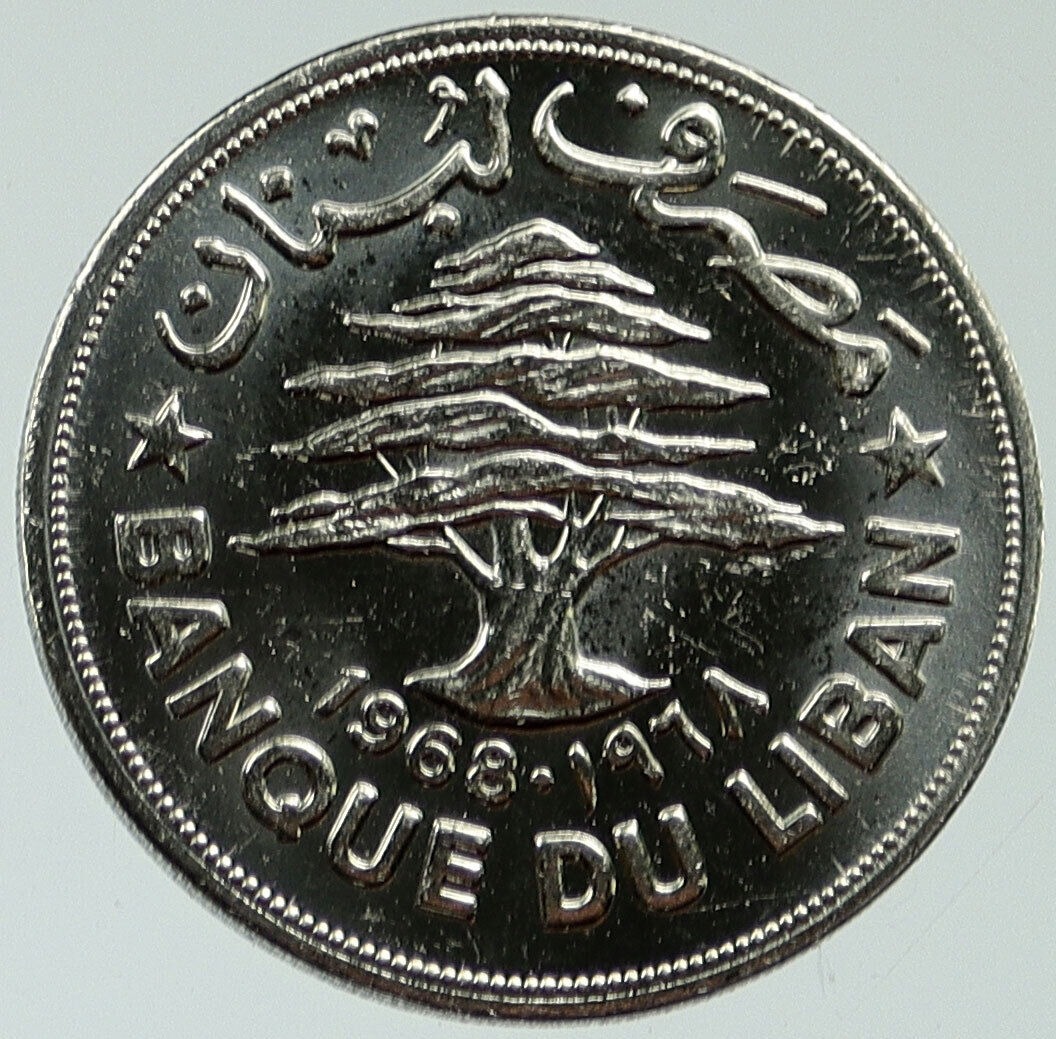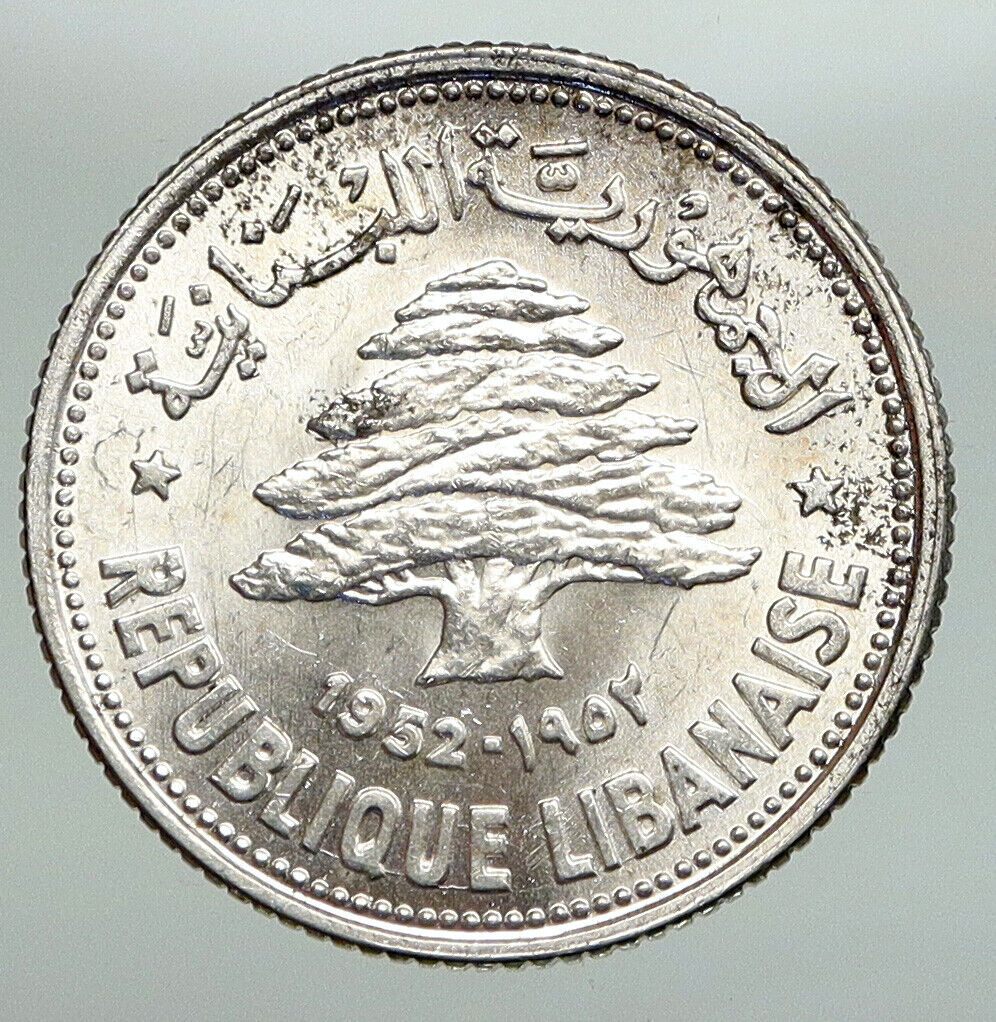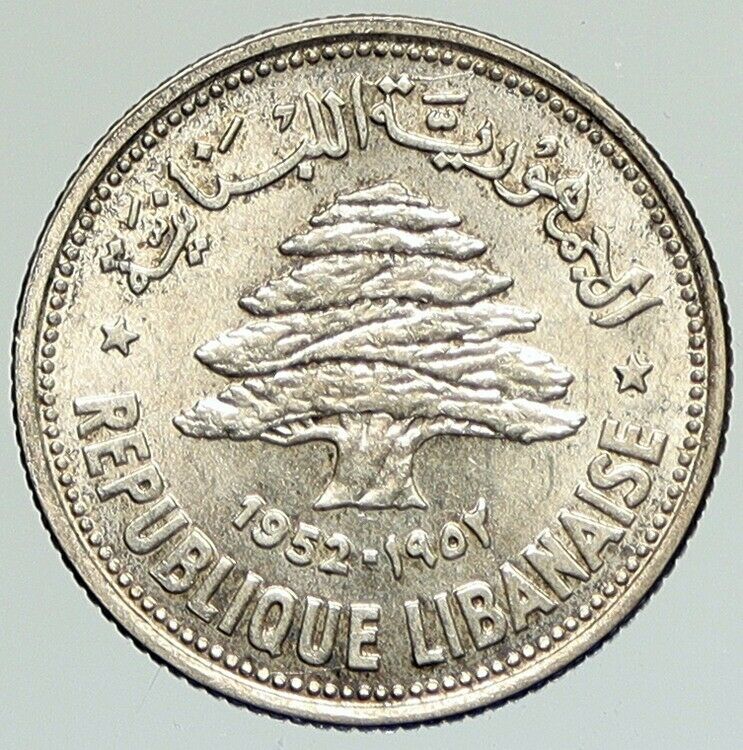|
Lebanon – 1980 Winter Olympics, Lake Placid
1980 Silver 10 Livres 38mm (18.82 grams) 0.500 Silver (0.3054 oz. ASW)
Reference: KM# 33, Schön# 33
REPUBLIQUE LIBANAISE 1980 الجمهورية اللبنانية ١٩٨٠ 10 L.L. ١٠ ل.ل , Stylized cedar with skier.
الالعاب الاولمبية الشتوية الثالثة عشرة XIII JEUX OLYMPIQUES D’HIVER LAKE PLACID 1980 لاك بلاسد ١٩٨٠ , Logo of Lake Placid Winter Olympics.
You are bidding on the exact item pictured, provided with a Certificate of Authenticity and Lifetime Guarantee of Authenticity.
 The 1980 Winter Olympics, officially known as the XIII Olympic Winter Games, was a multi-sport event which was celebrated from February 13 to February 24, 1980, in Lake Placid, New York, United States. This was the second time the Upstate New York village hosted the Games, after 1932. The only other candidate city to bid for the Games was Vancouver-Garibaldi, British Columbia, Canada, which withdrew before the final vote (though Vancouver would eventually win the bid to host the 2010 Winter Olympics.) The 1980 Winter Olympics, officially known as the XIII Olympic Winter Games, was a multi-sport event which was celebrated from February 13 to February 24, 1980, in Lake Placid, New York, United States. This was the second time the Upstate New York village hosted the Games, after 1932. The only other candidate city to bid for the Games was Vancouver-Garibaldi, British Columbia, Canada, which withdrew before the final vote (though Vancouver would eventually win the bid to host the 2010 Winter Olympics.)
The mascot of the Games was “Roni”, a raccoon. The mask-like rings on a raccoon’s face recall the goggles and hats worn by many athletes in winter sports. The sports were played at the Olympic Center, Whiteface Mountain, Mt. Van Hoevenberg Olympic Bobsled Run, the Olympic Ski Jumps, the Cascade Cross Country Ski Center, and the Lake Placid High School Speed Skating Oval.
The selection process for the 1980 Winter Olympics consisted of one bid, from Lake Placid, New York, United States. It was selected at the 75th International Olympic Committee (IOC) Session in Vienna on October 23, 1974.
Notable highlights included:
- The United States men’s ice hockey team, composed mostly of collegiate players and not predicted to advance beyond group play, won the gold medal. The United States team’s 4–3 win over the veteran and professional Soviet team, which came into the 1980 Games having won four consecutive Olympic gold medals, became known as the “Miracle on Ice” in US culture. The win captured the hearts of Americans, even though it was the win against Finland that secured the gold medal.
- Eric Heiden of the United States won gold in the 500m, 1000m, 1500m, 5000m, and 10,000m speed skating events, setting four Olympic records and one world record (10,000m) in the process and delivering 83% of the American gold medals (the only other gold, as noted above, was won by the hockey team). Heiden became the first person to win all five speed skating events, the first of only three to win five gold medals in individual events at a single Games (either Summer or Winter), and is still the only athlete to win five gold medals at one Winter Games.
- Sweden’s Ingemar Stenmark won both the giant slalom and the slalom.
- Hanni Wenzel won the women’s giant slalom and slalom, making Liechtenstein the smallest country to produce an Olympic champion.
- Ulrich Wehling of East Germany and Irina Rodnina of the USSR won their respective events for the third time, Wehling in Nordic combined and Rodnina in pairs figure skating.
- Aleksandr Tikhonov of the USSR earned his fourth straight gold medal as part of the 4 × 7.5 km biathlon relay team.
- Nikolay Zimyatov of the USSR earned three gold medals in cross-country skiing.
- Robin Cousins won gold for Great Britain in the men’s singles figure skating.
- East Germany won the most medals overall (23) but had fewer golds (9) than the USSR (10).
- In possibly the most dramatic duel of the games, Sweden’s Thomas Wassberg edged Finland’s Juha Mieto in the 15 km cross-country skiing by 0.01 seconds, the closest margin of victory ever in Olympic cross-country skiing.
- Although they did not get any medals, the People’s Republic of China entered the Olympic Games for the first time after the IOC agreed to designate the Republic of China “Chinese Taipei”.
- Lake Placid 1980 marked the first use of artificial snow in Olympic competition.
Lake Placid 1980 was the last Olympics to be opened by the Vice President of the United States, as 1980 was a Presidential election year.
 Lebanon, officially known as the Lebanese Republic (Arabic: الجمهورية اللبنانية, romanized: al-Jumhūrīyah al-Lubnānīyah, Lebanese Arabic pronunciation: [elˈʒʊmhuːɾɪjje lˈlɪbnɛːnɪjje]; French: République libanaise), is a country in Western Asia. It is bordered by Syria to the north and east and Israel to the south, while Cyprus is west across the Mediterranean Sea. Lebanon’s location at the crossroads of the Mediterranean Basin and the Arabian hinterland facilitated its rich history and shaped a cultural identity of religious and ethnic diversity. At just 10,452 km2 (4,036 sq. mi.), it is the smallest recognized sovereign state on the mainland Asian continent. Lebanon, officially known as the Lebanese Republic (Arabic: الجمهورية اللبنانية, romanized: al-Jumhūrīyah al-Lubnānīyah, Lebanese Arabic pronunciation: [elˈʒʊmhuːɾɪjje lˈlɪbnɛːnɪjje]; French: République libanaise), is a country in Western Asia. It is bordered by Syria to the north and east and Israel to the south, while Cyprus is west across the Mediterranean Sea. Lebanon’s location at the crossroads of the Mediterranean Basin and the Arabian hinterland facilitated its rich history and shaped a cultural identity of religious and ethnic diversity. At just 10,452 km2 (4,036 sq. mi.), it is the smallest recognized sovereign state on the mainland Asian continent.
 The earliest evidence of civilization in Lebanon dates back more than seven thousand years, predating recorded history. Lebanon was the home of the Canaanites/Phoenicians and their kingdoms, a maritime culture that flourished for over a thousand years (c. 1550-539 BC). In 64 BC, the region came under the rule of the Roman Empire, and eventually became one of the Empire’s leading centers of Christianity. In the Mount Lebanon range a monastic tradition known as the Maronite Church was established. As the Arab Muslims conquered the region, the Maronites held onto their religion and identity. However, a new religious group, the Druze, established themselves in Mount Lebanon as well, generating a religious divide that has lasted for centuries. During the Crusades, the Maronites re-established contact with the Roman Catholic Church and asserted their communion with Rome. The ties they established with the Latins have influenced the region into the modern era. The earliest evidence of civilization in Lebanon dates back more than seven thousand years, predating recorded history. Lebanon was the home of the Canaanites/Phoenicians and their kingdoms, a maritime culture that flourished for over a thousand years (c. 1550-539 BC). In 64 BC, the region came under the rule of the Roman Empire, and eventually became one of the Empire’s leading centers of Christianity. In the Mount Lebanon range a monastic tradition known as the Maronite Church was established. As the Arab Muslims conquered the region, the Maronites held onto their religion and identity. However, a new religious group, the Druze, established themselves in Mount Lebanon as well, generating a religious divide that has lasted for centuries. During the Crusades, the Maronites re-established contact with the Roman Catholic Church and asserted their communion with Rome. The ties they established with the Latins have influenced the region into the modern era.
The region eventually was ruled by the Ottoman Empire from 1516 to 1918. Following the collapse of the empire after World War I, the five provinces that constitute modern Lebanon came under the French Mandate of Lebanon. The French expanded the borders of the Mount Lebanon Governorate, which was mostly populated by Maronites and Druze, to include more Muslims. Lebanon gained independence in 1943, establishing confessionalism, a unique, Consociationalism-type of political system with a power-sharing mechanism based on religious communities. Bechara El Khoury, President of Lebanon during the independence, Riad El-Solh, first Lebanese prime minister and Emir Majid Arslan II, first Lebanese minister of defence, are considered the founders of the modern Republic of Lebanon and are national heroes for having led the country’s independence. Foreign troops withdrew completely from Lebanon on 31 December 1946, although the country was subjected to military occupations by Syria that lasted nearly thirty years before being withdrawn in April 2005 as well as Israel for fifteen years before being withdrawn in May 2000.
Despite its small size, the country has developed a well-known culture and has been highly influential in the Arab world, powered by its large diaspora. Before the Lebanese Civil War (1975-1990), the country experienced a period of relative calm and renowned prosperity, driven by tourism, agriculture, commerce, and banking. Because of its financial power and diversity in its heyday, Lebanon was referred to as the “Switzerland of the East” during the 1960s, and its capital, Beirut, attracted so many tourists that it was known as “the Paris of the Middle East”. At the end of the war, there were extensive efforts to revive the economy and rebuild national infrastructure. In spite of these troubles, Lebanon has the 7th highest Human Development Index and GDP per capita in the Arab world after the oil-rich economies of the Persian Gulf. Lebanon has been a member of the United Nations since its founding in 1945 as well as of the Arab League (1945), the Non-Aligned Movement (1961), Organisation of the Islamic Cooperation (1969) and the Organisation internationale de la francophonie (1973).
|




 The 1980 Winter Olympics, officially known as the XIII Olympic Winter Games, was a multi-sport event which was celebrated from February 13 to February 24, 1980, in Lake Placid, New York, United States. This was the second time the Upstate New York village hosted the Games, after 1932. The only other candidate city to bid for the Games was Vancouver-Garibaldi, British Columbia, Canada, which withdrew before the final vote (though Vancouver would eventually win the bid to host the 2010 Winter Olympics.)
The 1980 Winter Olympics, officially known as the XIII Olympic Winter Games, was a multi-sport event which was celebrated from February 13 to February 24, 1980, in Lake Placid, New York, United States. This was the second time the Upstate New York village hosted the Games, after 1932. The only other candidate city to bid for the Games was Vancouver-Garibaldi, British Columbia, Canada, which withdrew before the final vote (though Vancouver would eventually win the bid to host the 2010 Winter Olympics.) Lebanon, officially known as the Lebanese Republic (Arabic: الجمهورية اللبنانية, romanized: al-Jumhūrīyah al-Lubnānīyah, Lebanese Arabic pronunciation: [elˈʒʊmhuːɾɪjje lˈlɪbnɛːnɪjje]; French: République libanaise), is a country in Western Asia. It is bordered by Syria to the north and east and Israel to the south, while Cyprus is west across the Mediterranean Sea. Lebanon’s location at the crossroads of the Mediterranean Basin and the Arabian hinterland facilitated its rich history and shaped a cultural identity of religious and ethnic diversity. At just 10,452 km2 (4,036 sq. mi.), it is the smallest recognized sovereign state on the mainland Asian continent.
Lebanon, officially known as the Lebanese Republic (Arabic: الجمهورية اللبنانية, romanized: al-Jumhūrīyah al-Lubnānīyah, Lebanese Arabic pronunciation: [elˈʒʊmhuːɾɪjje lˈlɪbnɛːnɪjje]; French: République libanaise), is a country in Western Asia. It is bordered by Syria to the north and east and Israel to the south, while Cyprus is west across the Mediterranean Sea. Lebanon’s location at the crossroads of the Mediterranean Basin and the Arabian hinterland facilitated its rich history and shaped a cultural identity of religious and ethnic diversity. At just 10,452 km2 (4,036 sq. mi.), it is the smallest recognized sovereign state on the mainland Asian continent. The earliest evidence of civilization in Lebanon dates back more than seven thousand years, predating recorded history. Lebanon was the home of the Canaanites/Phoenicians and their kingdoms, a maritime culture that flourished for over a thousand years (c. 1550-539 BC). In 64 BC, the region came under the rule of the Roman Empire, and eventually became one of the Empire’s leading centers of Christianity. In the Mount Lebanon range a monastic tradition known as the Maronite Church was established. As the Arab Muslims conquered the region, the Maronites held onto their religion and identity. However, a new religious group, the Druze, established themselves in Mount Lebanon as well, generating a religious divide that has lasted for centuries. During the Crusades, the Maronites re-established contact with the Roman Catholic Church and asserted their communion with Rome. The ties they established with the Latins have influenced the region into the modern era.
The earliest evidence of civilization in Lebanon dates back more than seven thousand years, predating recorded history. Lebanon was the home of the Canaanites/Phoenicians and their kingdoms, a maritime culture that flourished for over a thousand years (c. 1550-539 BC). In 64 BC, the region came under the rule of the Roman Empire, and eventually became one of the Empire’s leading centers of Christianity. In the Mount Lebanon range a monastic tradition known as the Maronite Church was established. As the Arab Muslims conquered the region, the Maronites held onto their religion and identity. However, a new religious group, the Druze, established themselves in Mount Lebanon as well, generating a religious divide that has lasted for centuries. During the Crusades, the Maronites re-established contact with the Roman Catholic Church and asserted their communion with Rome. The ties they established with the Latins have influenced the region into the modern era. 




